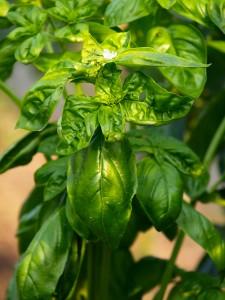Before our modern synthetic scents were created, herbs were an important aspect of everyday living. They were used for many functions including dyes, medicines, room deodorizers, and of course cooking. It is these culinary uses that most people think of today when they think of herbs, and the most popular reason they are grown in home gardens.
Most herbs in temperate climates are herbaceous – they have non-woody stems, and die back to the ground each fall. Many herbs are perennial, although some are annual. Some of these annual herbs may reseed, however, appearing year after year, and so may give the false impression of being perennial. Most herbs need sun (over 6 hours a day), a well-drained soil, and little if any fertilizer to grow best. In fact, finished manure or compost applied each spring is usually all that is needed.
The best herbs for your garden
Basil (Ocimum basilicum), an annual, is one of the most popular herbs, growing one to two feet high. You can pinch the white or purple flowers off to help make the plant branch. The different types of basils have various leaf sizes and colors, but generally the upright plants have purple or bright green leaves. The pungent fragrance enhances tomato sauces and dishes, and Basil also can be made into a delicious pesto. One type of basil has a cute, small globe-shaped form with tiny leaves, which is an excellent choice to use along a path or to edge a bed.
Parsley (Petroselinum crispum ) is another of the all-time favorite cooking herbs. If you grow only one herb, make it this one. Parsleys are popular in pots indoors on kitchen windowsills. Technically a tender biennial, it is grown as an annual from slow-to-germinate seeds. Parsley is the popular garnish on plates in many restaurants and can be used in salads, soups, and other dishes. It also makes a nice edging to beds, with selections having flat, ruffled, or curled leaves.
Dill (Anethum graveolens) also makes the top three of favorite annual herbs. It is used as a spice and, of course, in pickles. Both the seeds and the feathery leaves are used. This is a tall herb, growing two to four feet high, depending on selection. It could be used in the middle of borders for a fine texture. Place carefully, as it can self sow.
Of the perennial herbs, a couple of tender types with woody stems also are popular. Bay laurel (Laurus nobilis) has thick, aromatic, evergreen leaves. It makes an attractive container plant to overwinter indoors if you have the room and a sunny window. The leaves can be dried and used to flavor soups, stews, and sauces. Rosemary (Rosmarinus officinalis) can be kept outdoors in summer in large pots, then brought indoors in winter into a bright, cool location. It can be used not only as an aromatic, but also in cooking for sauces, soups, teas, and for flavoring lamb dishes.
Mints (Mentha) are among the most common perennial herbs and should be sited with care as the roots are quite aggressive. To keep mints under control, plant in containers, keep well watered, and re-pot often to keep plants vigorous. Peppermint and spearmint are the most popular, but you also can plant other types such as apple and lemon mints. Mints are used medicinally, as well as in cooking to flavor tea, jelly, salads, candy, ice cream, and beverages.
Chives (Allium schoenoprasum) are familiar to most gardeners. They resemble and smell like small onion plants and can be chopped and used to flavor salads, soups, and egg dishes. The pinkish purple flowers are attractive, especially if grown in a row along a walk, but make sure you cut off these flowers right after bloom. If you allow them to go to seed, you will have chives everywhere and forever!
Thyme (Thymus) is a perennial herb that should be included in every culinary garden. Thyme is a very low groundcover plant, making it suitable for rock gardens, planting between stones in walks and patios, and even for growing in lawns. There are many species and selections, some more ornamental than others in flowers or foliage. Strongly scented thymes are used to flavor meats or in soups.
Garden Sage (Salvia officinalis), also a perennial, is the one of the many sages used in cooking. Others, such as the pineapple sage, are grown for their scented leaves or ornamental qualities. Garden sage is useful to flavor turkey, chicken, stuffing, and sausage.
Leaves of Lemon Balm (Melissa officinalis) are used in teas and desserts. Another less common perennial herb, this one can spread by roots or seeds so place it carefully, or grow in a pot. It prefers a moist soil, and will tolerate some shade.
Greek Oregano (Origanum vulgare subsp. hirtum) with its spicy flavor, and the related Marjoram (O. majorana) with its mild and sweeter flavor, are both good in casseroles, soups, stews, egg and meat dishes. Both these perennials are good, but less common, culinary herbs.
Cilantro (Coriandrum) leaves have become popular recently for use in salsas and guacamole. Its seeds—Coriander—are ground to use in desserts and baked goods, and dried to make curry powder. This annual can be a challenge in some gardens, and should be sown several times during the season for successive crops of leaves.
More on herbs and their history can be found online from the National Garden Bureau (www.ngb.org).
This article was originally written by Dr. Leonard Perry, a guest author for bigblogofgardening.com. For the original article and more information, please click HERE.

Friends Read Free